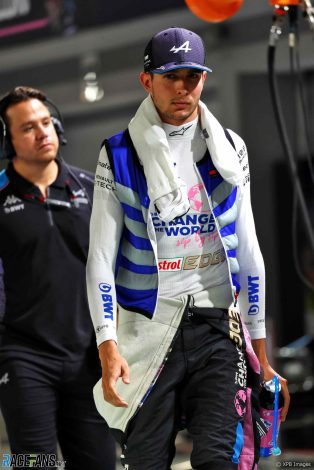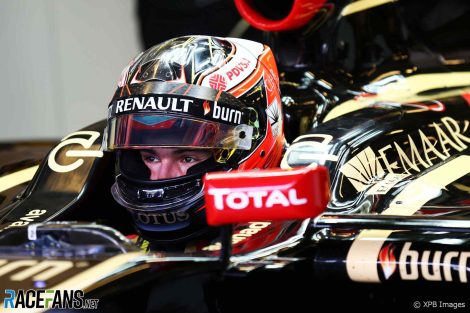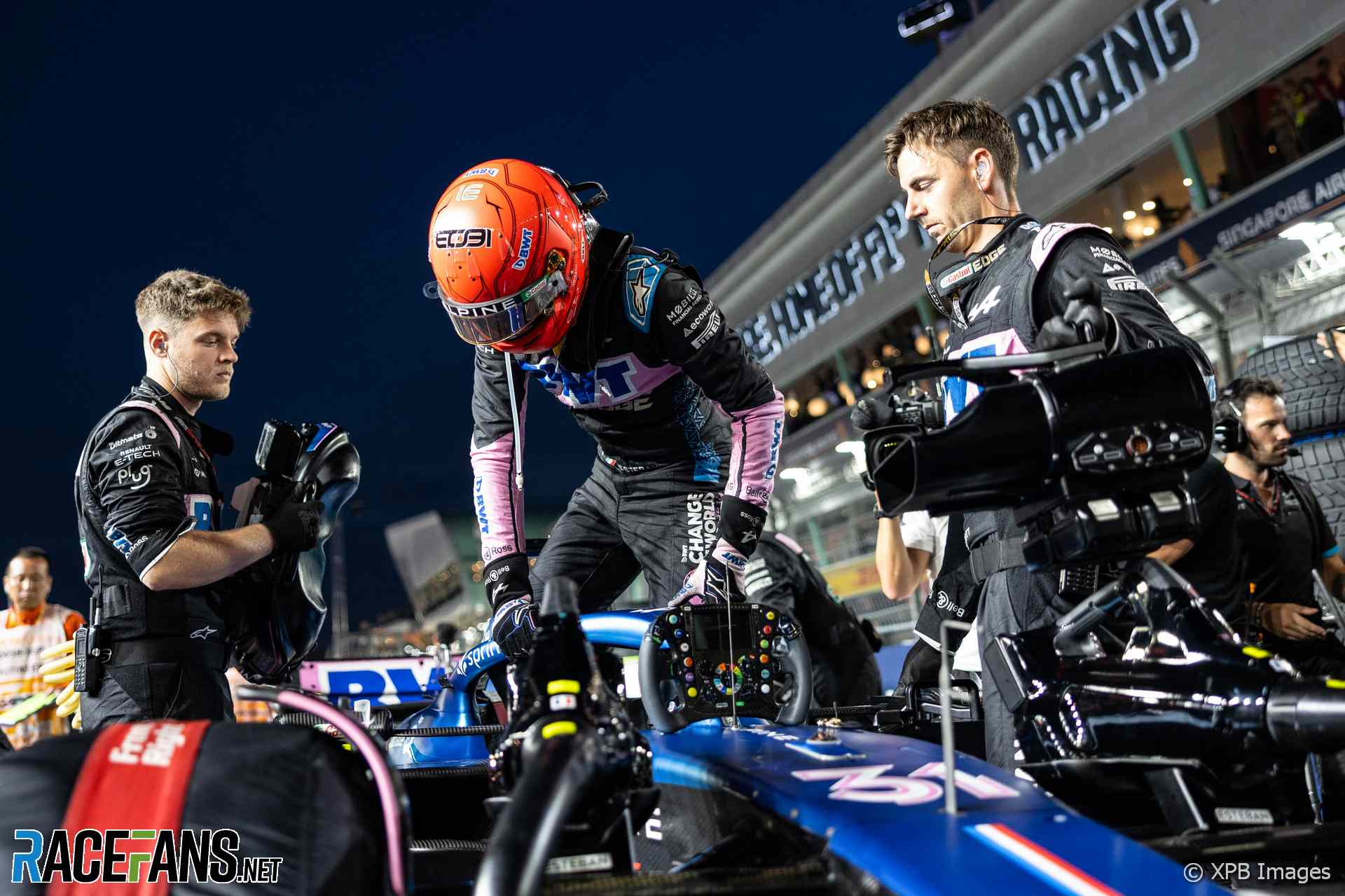Formula 1’s tallest driver has been working with the FIA to develop its rules on car dimensions to prevent all but the shortest racers being at a disadvantage.
Esteban Ocon is currently the joint tallest driver in Formula 1 at 186cm. Only Alexander Albon measures up to the Alpine driver, while at the other end of the scale Yuki Tsunoda is a mere 159cm tall.Shorter drivers are at an automatic advantage as it is easier for them to weigh less. F1 car designers also prefer shorter racers as it allows them to reduce cockpit dimensions.
Some progress has already been make in equalising the competition between shorter and taller drivers, ensuring the latter are not incentivised to push their diets to dangerous extremes to bring their weight down.
In 2019 F1 introduced a minimum 80kg weight limit for drivers, which takes into account their helmet, race suit and shoes. Since all drivers are capable of staying below that figure, it gives even Ocon’s Alpine team the option to use ballast.
Speaking at the Singapore Grand Prix, a notoriously tough race for drivers’ bodies as high temperatures and humidity lead to significant fluid loss over the near-two-hour long race, Ocon explained why his height means he has to take a different approach to training compared to most of his rivals.
“My preparation and my physical training is very different to any other drivers,” said Ocon. “It’s specific to me.
Advert | Become a RaceFans supporter and
“I’m somebody who is very lean in general. I have only 4% body fat, and all of that makes me need to eat constantly or drink constantly.

The demands of a race like Singapore are little different for Ocon than they are for other drivers. “I don’t lose more weight [in the race], because it’s mostly water that you lose,” he explains. “Maybe I lose less fat because I don’t really have any.
“But for me, it’s important to have a very good routine, to keep my fat mass and weight as high as it [is allowed to] go, especially during the year [for] my strength. It can be easily lost during the season because we are travelling so much, we are doing so many things. If I lose the little [fat] that I have already, I would get sick quite easily.”
Since coming into F1 in 2016, Ocon says he’s “never been in a better place physically” than he is now and has no problem with the added demands placed by F1’s sprint events, such as the forthcoming one in Qatar. “I’ve been recently running or weightlifting and I’ve been very happy with my health and all that sort of stuff recently,” he said.
“Of course I’m still tall. That I can’t change. But I have no problem with the weight, it’s always been a strength of mine in cars. I’ve never had an issue where I suffered physically more than anyone. And recently I can do two-race grands prix with no problem.”
Advert | Become a RaceFans supporter and
However fitting in racing cars comfortably hasn’t always been easy for the 2021 Hungarian Grand Prix winner. “It’s always been difficult on that side, especially in the junior categories,” he admitted.

“That was just legal, but tricky. The centre of gravity makes you high. You are not comfortable with your knees when you turn.”
Similarly, when Ocon made his F1 race debut in 2016 he was a mid-season signing for Manor, who had started the year with Pascal Wehrlein and Rio Haryanto, who were both shorter than him.
“The Manor car was the same. I had to turn, hit my knees and then pass the point to be able to turn again. So in all the high-speed corners I was alright, but all the low-speed ones I had to turn more than 90 [degrees]. My suit was like black at the end of the race because I was just scratching it all the time. So it was not comfortable at all. So that has caused me issues. Since then I’ve had cars which were big enough.”
However Ocon admitted it’s been “useful that I’m on one extreme of the size” as it has influenced F1’s rulemakers who have introduced changes to ensure that car dimensions in various categories enable drivers as tall as Ocon to drive without undue discomfort.
“The FIA have worked hard on taking my measurements, seeing how I’m fitting in cars and replicating that to all the cars as a mandatory measure.”
Advert | Become a RaceFans supporter and
Become a RaceFans Supporter
RaceFans is run thanks in part to the generous support of its readers. By contributing £1 per month or £12 per year (or the same in whichever currency you use) you can help cover the costs of creating, hosting and developing RaceFans today and in the future.
Become a RaceFans Supporter today and browse the site ad-free. Sign up or find out more via the links below:
2023 Singapore Grand Prix
- Singapore and Austin retirements cost me top 10 championship place – Ocon
- How Ocon’s “extreme” height for an F1 driver is helping other tall racers
- Steward’s admission Verstappen should have had penalty frustrates his rivals
- Drivers back Singapore qualifying tweak as rule changes again for Japanese GP
- Piastri “much more comfortable” at new circuits than at start of rookie season





Zann (@zann)
1st October 2023, 13:13
It’s a sensitive subject isn’t it, for a lot of accounts :)
Personally I think it’s a bit of a pity, when most sports already are easier for big people – tennis, golf, swimming etc etc
Electroball76
1st October 2023, 13:24
Ah the pains of being tall, thin, young, rich, white, male, European, talented, successful, good looking, ambitious, down to earth and friendly..
S
1st October 2023, 14:23
And human, just like everyone else….
Jere (@jerejj)
1st October 2023, 17:26
S Indeed
Davey
2nd October 2023, 21:10
And being an one-win-wonder.
elchinero (@elchinero)
1st October 2023, 13:50
“186cm”
(gets calculator out)
“6.1 feet”
José Lopes da Silva
1st October 2023, 16:32
Do you want the non-British readers of this portal to mock that measurement system?
David (@nvherman)
2nd October 2023, 11:51
I’m British, and I know full well how tall 186cm is. I myself am 188cm.
It’s about time the UK joined the rest of the developed world and went fully metric (we are for most things, except for road signs (not the roads themselves) and liquid measures for beer/cider).
RR
1st October 2023, 17:05
Good job he is not trying basketball as that would be regarded as dwarfish.
Renato
1st October 2023, 20:11
Check out Muggsy Bogues. Great NBA player. 1.60m.
Jere (@jerejj)
1st October 2023, 17:28
@elchinero So? Way more people comprehend cm & m better than feet-inch.
Glynh
1st October 2023, 22:29
@jerejj He’s just making a helpful comment for people who use a different system. Why shouldn’t he help people just because there’s less of them.
Coventry Climax
2nd October 2023, 0:43
It would actually be more helpful if those people started to use the ISO metric system as well, and get a feel for what length 1 meter 86 cm is.
Jere (@jerejj)
2nd October 2023, 7:10
Coventry Climax
I agree & for example, while I can convert feet-inch amounts from around 6”0 to 6”4 to their cm or m equivalents quite well, the rest are more difficult to convert on the fly.
David (@nvherman)
2nd October 2023, 11:52
@Coventry Climax or metre, as it is correctly spelled :D
Bullfrog (@bullfrog)
2nd October 2023, 21:11
It’s about one unit of social distancing.
Coventry Climax
2nd October 2023, 21:18
@nvherman
Ah, t’as raison! Le ‘metre’ original est stocké en Paris, il est donc logique de l’écrire en Francais aussi!
Jammer dat de Nederlanders und die Deutschen das nicht begreifen.
E os portugueses confundem-no com um metro. ;-)
You still with me?
Fred Fedurch
1st October 2023, 14:10
A lot of pro cyclists are in the same boat as Esteban re: stripping too much fat from his body. I remember being at a Q&A with Greg Lemond and he said during the season he could drink bacon grease if he wanted to and his body would simply convert it to fuel. It was near impossible for him at his size/BM to consume enough calories.
Fer no.65 (@fer-no65)
1st October 2023, 15:33
I’m 185 cm high. And it’s a pain… It’s actually 99% of the reason why I didn’t pursue a career in F1. The other 1% was lacking money, talent, ability, connections, training…
MacLeod (@macleod)
2nd October 2023, 8:08
@fer-no65 Lol but that is the reason i never came far in the Motorsport even i had the talent to get far enough during my Cart years I did well enough vs my peers at that time. (Like a certain A.Senna Bleekemolen)
But when i passed my 1.80m marker ( I end up at 1.85m) they told me i got to big to contine further and i dropped carts after that. I always was jalours on short people who never came above 1.70m
But that Ocon paves the way for bigger persons is super and i can support that with my heart (even i don’t like Ocon myself)
MichaelN
1st October 2023, 15:42
Just 4% body fat? That’s quite something!
It’s good to see the FIA using Ocon as a sort of standard to help make racing more accessible to taller people. But there are quite a few European countries where the average male is taller than 180cm, so even Ocon is barely above average in that sense.
Renato
1st October 2023, 20:17
That’s bs. 4% is ultra ripped. Ocon isn’t.
Bodybuilders range from 3 to 8% in competition. Think Ronnie Coleman.
David (@nvherman)
2nd October 2023, 11:57
I’m not sure you know what you’re talking about: just because someone isn’t a bodybuilder does not mean they can’t have low body fat. Ocon is an athlete who is fit and strong enough to drive a Formula 1 car for at least a full race distance, he’s not going to be unfit. Weighing 70kg at 186cm tall is pretty impressive, it gives him a BMI of 20.
Keith Campbell (@keithedin)
2nd October 2023, 12:57
Having low percentage bodyfat is not the only factor in how ‘ripped’ you are. Plenty of professional athletes have body fat percentages around a similar level – long distance runners, cyclists etc, without any of them resembling bodybuilders. I recall Mark Webber also saying he was around 4% body fat when he was training full time, so I can easily believe Ocon is around 4% too.
MacLeod (@macleod)
2nd October 2023, 8:10
That was also the reason that the driver weight limiet was dropped everyone must weight a certain amount i thought it was 75kg if you below that you get balast.
Darryn Smith (@darryn)
1st October 2023, 17:01
Same height as Berger. Kind of a nothing article since the cars are bigger now.
Jere (@jerejj)
1st October 2023, 17:27
I never realized Berger was that tall & thus among the tallest full-time drivers in his time.
Simon
2nd October 2023, 16:38
🤨
Jere (@jerejj)
1st October 2023, 17:26
Russell is actually the tallest at 187.96 cm (& Tsunoda 161 cm, with some other height figures also shown incorrectly on the Internet) based on his words on the pre-2022 Miami GP Thursday (he said he’s 6”2 in the Weekend Warm-Up video on F1’s official YT channel), although everything from 184 to 187 is so close that the same effect equally applies to all within this range that have raced in F1 such as Latifi, Giovinazzi, Di Resta, Sirotkin, Hartley, Kubica, Webber, & Hulkenberg rather than only Ocon, so Ocon’s situation height-wise isn’t any more extreme, although weight is another matter with him always been noticeably narrow-bodied.
Jere (@jerejj)
1st October 2023, 20:54
I intended to have ) after Tsunoda’s height.
Jere (@jerejj)
1st October 2023, 20:55
Never mind, I forgot I already had it in the right place.
Simon
2nd October 2023, 16:36
https://us.v-cdn.net/6028689/uploads/editor/7o/rxgz22gj5vjb.gif
Treble #6 in any case
Asd
1st October 2023, 18:48
I find his height neither extreme, nor “extreme”, as there were always drivers his height in F1 while the average height of F1 drivers was shorter, so they stood out more in the past than they do now.
Gerhard Berger racing in the 80s and 90s at 185cm was never found anything else but simply tall, there was Alexander Wurz at 186cm in the 90s, there was Kubica at 184cm.
I remember Berger keeping his head to the side on longer straights so the upper air inlet got more air. That was such a classic image. I don’t think Ocon ever needed to do that.
Jere (@jerejj)
1st October 2023, 20:54
True & like with Berger, I never realized Wurz is in the same height range.
D.J. Smit
2nd October 2023, 9:25
Justin Wilson race in the 2003 at 1.93cm tall. When Jaguar poached him from Minardi they had to build a special chassis for him. That’s what I would call extremely tall for an F1-driver. Dan Gurney and H.J. Stuck were around that height as well I think. Stuck even said the switch to ‘cab forward’-designs in the 80’s made it impossible for him to stay in F1.
Ciaran (@ciaran)
1st October 2023, 21:07
Interesting stuff, lots of little details I never even thought about.
Around 2013-ish I remember a lot of concern over tall drivers like Mark Webber and Jean-Eric Vergne looking quite malnourished in an attempt to keep weight down. And Singapore was a particular cause for concern still. It looks to be a little better these days hopefully, the minimum weight for drivers rule seems to have helped.
Maisch (@maisch)
2nd October 2023, 10:16
Yeah, i remember an article with Marcus Ericsson on the subject, the team couldnt reach the weight limit so he was starved out to unhealthy levels beacuse he was to tall, and they were still overweight compared to smaller drivers. The minimum weight was a really good rule, so the drivers can be well trained and not having to eat like a starved out supermodel.
Dr.D
1st October 2023, 21:27
I am/was a reasonable long distance runner. But knew I would never be near the top. Because I am quite a bit longer. Wouldn’t have had a problem with the weight either. Only after 40 I get over 80kg.
Life is not fair (no matter the training, I could not get even near 70kg as a teenager).
bernasaurus (@bernasaurus)
2nd October 2023, 1:54
It might seem a somewhat trivial issue, but it’s very real. ‘Growth spurts’ in karting can lead to some somewhat comical solutions where kids have their knees either side of the wheel to keep the centre of gravity in the right place and the Ackerman turned up so they could just ‘flick’ the wheel. People would speculate what would happen if Lewis grew, he seemed very small as a kid (his talent was very evident so I’m sure he’d have been fine in the end). But his smallness was considered a big advantage.
Fitting in the kart every weekend becomes an issue for many. It might seem like a ‘first world issue’ and I guess it is, but where motorsport has many massive plusses (boys and girls can race equally), being tall is a problem with no paybacks. Ballast comes off, and then there isn’t really much that can be done after that. You can say that Steph Curry is short (he’s still 6’3) but he utilises it very well with change of direction and generally being fantastic at Basketball.
Messi and Ronaldo are very different builds. They adapt and use their physicality to their advantage, Messi can dance around people at close quarters and Ronaldo blast past with acceleration and all the other stuff they can both do.
But a lanky racing driver is of no use to anyone. There will always be ‘outliers’, Usian Bolt, John Isner etc. But if you aggregate them against those they compete against, their height is something they compensate for. I think you can see it in F1 drivers just by looking at them, Alex Albon and George Russell aren’t tall by modern standards but they have the build of cyclists and cyclists are worried about aero, Alex and George shouldn’t be, but weight is why they look like 90’s dehydrated models.
Jere (@jerejj)
2nd October 2023, 7:06
I’m somewhat unsure what you mean by aren’t tall by modern standards unless that’s about life or sports generally rather than F1 specifically.
David (@nvherman)
2nd October 2023, 12:11
@bernasaurus
definitely incorrect: Albon is 186cm tall, Russell is 185cm.
Average height for a male is 175cm in the UK, the popuplation I could find with the tallest average is Bosnia and Herzegovina at 183.9cm. So, still shorter on average than Ocon, Albon and Russell
Bullfrog (@bullfrog)
2nd October 2023, 21:14
How high is an F1 podium step? If (as if) Tsunoda and Ocon finished 2nd & 3rd behind Verstappen, would Esteban still be looking down at Yuki?